If you recall the last time you stayed in the hotel, you probably didn’t use the traditional key; Instead, you will get a digital key similar to a credit card. We always see innovations that change the way we interact with enterprises and services. For a long time, the hotel industry has been a pioneer. The most noteworthy is the shift from locks and keys to digital access control.
In this guide, we will discuss some reasons why key cards are so popular in the hotel industry and why they become the primary solution for hotel security and access control.
1. What is the Hotel Key Card?
The key card technology used by hotels may vary by country/region, even among chain stores, but the overall concept is the same, that is digital access control. The hotel key card is an alternative to the metal key, providing a simple way for guests to enter the room through the reception desk using the only assigned key card.
With the reduction of traditional lock and key systems, hotels have become one of the first industries to promote keyless access systems. This technology has recently been integrated into many different automobiles and the entire automobile industry. This means that you no longer need to unlock or start the car manually with the key, just put it nearby.
This is the same as the working principle of the hotel key card. When the card is within the radius, the data is scanned through the card reader. In addition to unlocking your room, the key card can also grant you access to the gym or swimming pool.
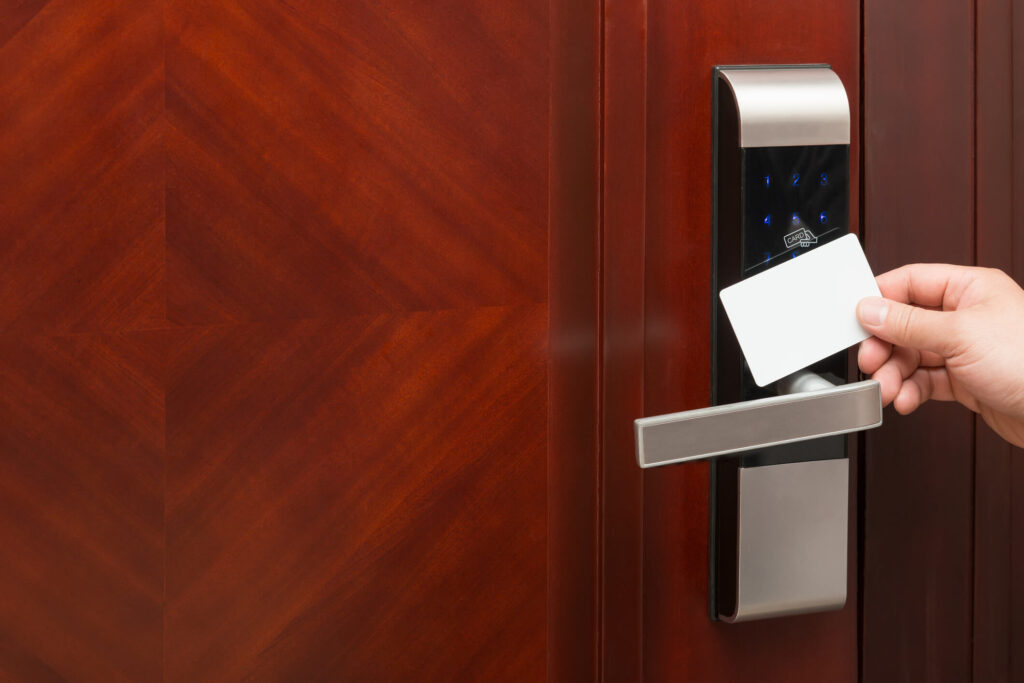
2. Type of Hotel Key Card
There are several options for hotel access control. For example, a similar technology is Key Fobs, but for the sake of simplicity, we will focus on Key Cards today. We will briefly introduce three common or used hotel key card types, which have some subtypes but cover the core areas.
- Magnetic stripe: It is probably the most common one. We have probably encountered it in the past decade or so. The magnetic stripe key card has a black strip that slides down through the card reader.
- Radiofrequency: It is often referred to as an inductive card, eavesdropping, or non-contact technology. This is a short-range card that can be held by the scanner to grant access rights within several CMs.
- Punch: It is usually outdated now, but it has become very popular in the past few years. The unique combination of punched cards will determine whether you can enter your room.

3. Main Components of Hotel Key Card
As you can see from the previous section, cards work in different ways and deploy different technologies. Having said that, let’s take a look at the core components of hotel key cards, which are quite common in different types.
- Card distributor: This is part of the system connected to the reception computer. It allows you to assign a blank key card to your room when you check in.
- Key card: The physical way you enter the room. Your key card is the place where data is temporarily stored and scanned when you arrive at the room.
- Door reader: How to scan your key card to grant you access to your room or other guest areas. The card reader determines whether you can enter according to the data on the key card.
- Indoor power supply equipment: Not always, but you can use the key card to power the hotel room. The card slot is usually near the front door of your room.
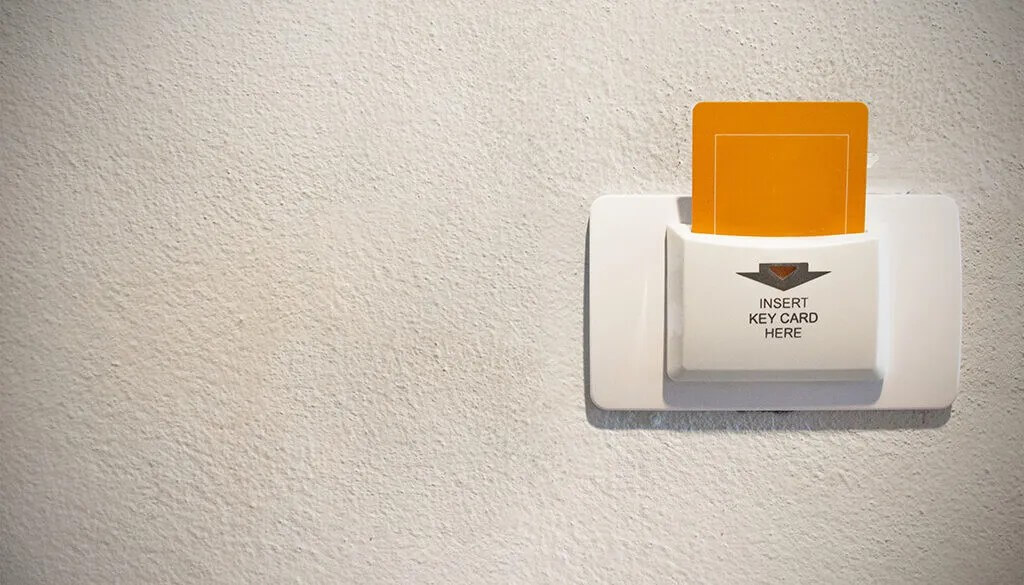
4. How does the Hotel Key Card Work?
As we mentioned, there are several different technologies that can be used for hotel access control, not only for room access control but also for limiting elevator control and even parking management. However, in terms of room access, the technologies used are usually quite comparable, and the core concepts are the same. The digital key is scanned or inserted at close range, allowing you to enter your room. Let’s understand the working principle of this process through a simple example, which will show you how the key card works in the hotel.
Step 1: Guest Check-in
You arrive at the hotel and go to the reception desk to check in. When you arrive at the counter, the front desk staff will take a key card and start the formalities.
Step 2: Assign Key Card
Each key card is blank, and then the front desk or concierge section will be equipped with door opening authority. Using the digital system, they will link your key card to your room. This is usually done through the keyboard connected to the computer, which will transfer temporary data to your key card.
Step 3: Open Your Door with Your Key Card
When you return to your room, you usually do one of the following two things: slide the card into the card reader or tap it on the card reader.
Both methods will scan your card, read data, grant you access rights, and unlock your door. The whole process usually takes less than a few seconds, and you may hear the sound of the mechanical device unlocking.
Step 4: Card Power Supply
In many hotels, your key card will actually power your room through a small card reader next to the door. This is a green initiative used by the hotel to reduce power consumption and provide secondary use for your card. The card reader is usually designed to be triggered by any credit card, not just your room key, so you can put your library card or things you don’t need there.
Step 5: Check Card Reset
When you check out, the card will be erased again so that you can reuse the new lock and door. This then allows the process to be restarted for the next guest. Since all cards can be connected to any door of the hotel, the value of each key card is much lower and it is easier to replace.
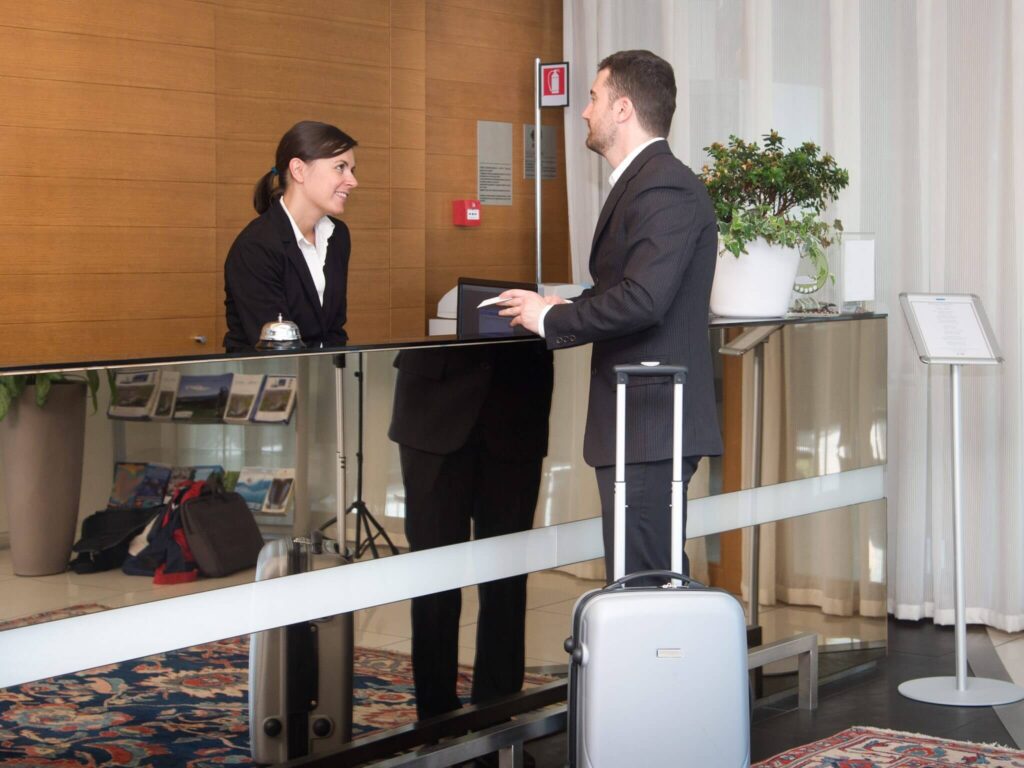
5. What are the Benefits of A Hotel Key Card?
Users, security, and operation benefits are the three aspects we will divide into when discussing hotel key cards.
1) User Benefits
The following will be introduced in detail:
- Lightweight
The difference between a key card and a traditional key will not have a significant impact on your overall carrying weight; however, it is much more difficult to have a key than a card that can be put into a wallet or with a payment card.
The design of the key card is easy to carry and will not bring you extra personal belongings. The key may be bulky and difficult to find a comfortable place to store it. On the other hand, the key card is more portable and portable.
- Fast and convenient
Being able to enter your room easily and quickly will make the whole process more smooth and improve the impression of guests on the hotel. Combining this with the simplicity of check-in and check-out, you will have an effortless process from beginning to end, which is specially designed for guests. Understanding how to create a successful guest experience is an important part of managing hotels and improving security.
2) Operational Benefits
The following will be introduced in detail:
- Easier to manage
Unlike traditional lock and key systems, you will be able to track and manage your access control system from a central computer. You will record who can access where, which keys are issued, and whether they have been returned or are still active.
This is very useful in an emergency because you can unlock all fire doors or exterior doors to provide a fast and safe exit.
- Cost-effectiveness
Another advantage of the hotel key card access control system is its incredible cost-effectiveness. Because each card can be reprogrammed countless times and the manufacturing cost is very low, you can easily replace any card you need. If you lose a card, it can be deactivated. If you lose a metal key, on the other hand, you will face the risk of security vulnerabilities and may even need to replace the lock.
3) Security Interests
The following will be introduced in detail:
- More difficult to copy
Having a system that is easy to issue new cards and difficult for laymen or guests to copy means that you will be safer on the whole. The key card access control of the hotel creates a more secure environment. You will not take the risk of guests copying the key card, just as they can use metal keys.
- More secure
There are many reasons why the key card system is more secure than other forms of security or access control. Take the lock and key system as an example. You don’t know who owns what keys. If you lose your entire system, it will be damaged. Let’s put this example in the context of a key card. Most hotel door lock systems actually allow you to disable the key card manually and remotely in case of loss, theft, or accidental removal.
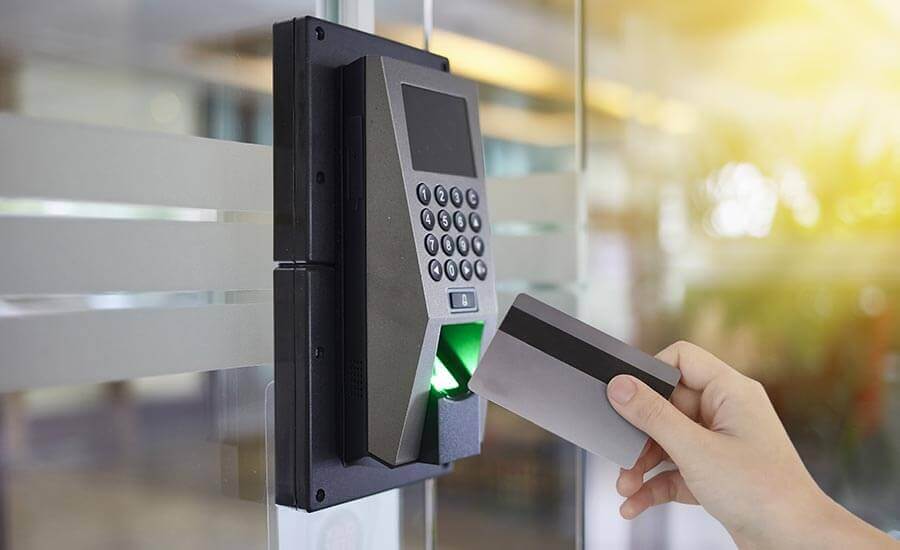
6. What Potential Dose Hotel Key Card Industry Have?
Now you should better understand the importance of hotel access control, and the decision to turn to digital security methods and stay away from locks and keys. It will certainly not be the last industry to implement this technology, as hotels are among the first. They have been ahead for a period of time and have taken another step towards a safer and ultimately keyless metal future.
In recent years, we have seen more and more industries turn to this security approach, seeking a cost-effective, easy-to-integrate, user-friendly solution that will not harm the business. The transition to these systems and the desire to expect them from the perspective of users and be willing to use this technology will ultimately determine the life of traditional keys.



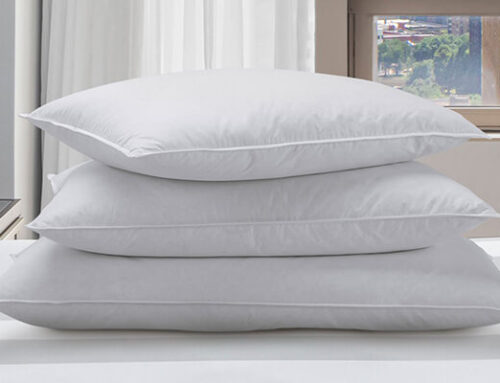

Leave A Comment